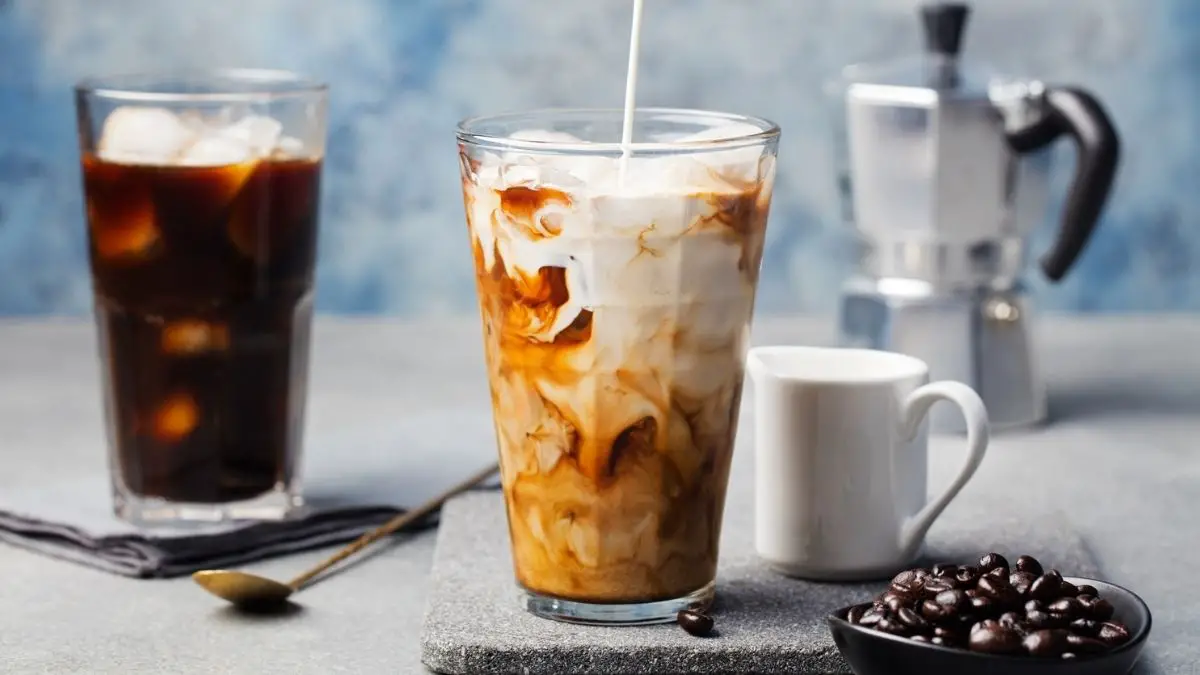I’ve always been a big fan of coffee and when I first heard about the frappuccino, I instantly thought it was a frappe and a cappuccino crossover, well true, but that’s not all there is to know between a frappe and the frappuccino.
To start, a frappuccino is a trademark product of Starbucks and only they get to sell the variants of it made with coffee or cream base and blended with ice, syrups, and milkshake and finally topped with whipped cream and spices. When it comes to frappe, it is a cold blend of instant coffee and ice.
Over the course of this discussion, we’d be looking at the histories, similarities, and differences between a frappe and the frappuccino and how either of them would suit your tastes depending on your mood and preferences.
The Origins Of Frappe
Born In Greece
The frappe isn’t a very common drink in the US, but rather it is the most popular iced coffee drink in Greece, and for good reasons. First of all, it was invented (accidentally) there by a man named Dimitris Vakondios during the Thessaloniki International Fair of 1957. Nescafe’s Giannas Dritsas exhibited a new chocolate beverage that was made simply by mixing it with milk in a shaker.
Dimitris was an employee of Giannas and wanted to take a quick coffee break with his Nescafe instant blend when the worst happened – the absence of hot water. So, not willing to skip his precious coffee break, he used cold water instead, and since instant coffee in cold water doesn’t blend very quickly, he found the shaker, poured the mixture in, and thus the Greek frappe was born.
A French Name
So technically, the original frappe was made this way and it was officially named in 1979 with a French word that meant “to be shaken or stirred,” but the French already has another shaken beverage known as the “lait frappè” or simply milkshake. Coincidentally, a frappe is also a classic milkshake in New England. Both of which are not the frappe we want to deal with here.
Ever since then, the drink was popularized entirely in Europe, and later found its way to the US and mostly sold under McDonald’s as the McCafe Frappe.
Instant Is The Norm
Most of the time, original frappes are made with instant coffee, a bit of sugar (for better foam), water, and ice, and that’s it. The natural foam is created by continuously blending, mixing, or shaking the mixture due to the physical and chemical properties of instant coffee, as explained by this brilliant article. The sugar helps stabilize the foam but is not necessary.
This is probably the first real difference I’ll mention between frappes and frappuccinos. Frappes require instant coffee and sugar to maintain the natural foams, but a frappuccino doesn’t since it can be made with cream and topped with whipped cream. Espresso or brewed coffee can also be used to make foam, you just have to blend them longer and the coffee taste becomes stronger.
A dalgona coffee is similar to a frappe, but the foam is made separately with cheap instant coffee, sugar, and a bit of water, then scooped into a glass or cup of milk.
The Origins Of Frappuccino
Not A Starbucks Original
Yep, I dare say Starbucks didn’t make the frappuccino firsthand but rather it was invented and first named by Andrew Frank, an employee of George Howell, the original owner of the Coffee Connection in Massachusetts. The original blend was made with coffee, sugar, milk, and ice and it came from a frozen yogurt machine to create its trademark smooth and creamy consistency. So it was then named frappuccino, a portmanteau of New England’s frappe milkshake and cappuccino coffee.
The introduction of the novel drink doubled their sales in Boston, but when Howell finally sold all his locations and the frappuccino rights to Starbucks in 1994, Starbucks soon became the receiver of that economic boom. Starbucks is the only one that has the right to sell the overrated beverage and it hoards about 20% of its annual sales worldwide, which makes up two-thirds of the entire frozen coffee drink market.
The Starbucks frappuccino now comes in more than 30 variants, and they also have bottled versions with coffee and mocha flavors that you can grab from just about any store with a beverage cooler.
However, needless to say, a lot of other brands have made their own “frappuccino,” just under a different, sometimes goofier, name. Dunkin’ Donuts Dunkaccino (Coolata), Wendy’s Frostycino, Baskin Robbins’ Cappuccino Blast, and Dairy Queen’s MooLatte are just a few of the popular sorts.
Frappe Vs Frappuccino
Ingredients
As I’ve already mentioned, the original Greek frappe is mostly made with just instant coffee, a bit of sugar (sometimes none), water, and ice blended with a shaker. Sometimes an espresso shot or brewed coffee is used and will produce a stronger aroma and taste. The New England frappe is simply a milkshake taken from the original French “lait frappe,” and isn’t made with coffee at all. Greek frappe will always be made with coffee and contains caffeine.
A frappucino originally contains coffee, sugar, milk, and ice blended together with a soft-serve machine, but today, Starbucks has made numerous tweaks to the product and now makes the base with a blender instead.
They use a coffee base known as Frappuccino Roast, a caffeinated type of instant coffee powder and water produced exclusively by Starbucks, with choices for affogato, espresso, decaf, or blonde espresso shots. Frappuccino Roast is designed as a room temperature ingredient and best-used cold, and since an espresso shot is served hot, this mix may alter the consistency (just the slightest bit) of your frappuccino. While the Frappuccino Roast doesn’t have a decaf version, adding decaf would mean replacing the original blend with decaf espresso shots instead.
The crème frappuccino line is also quite popular and this is another difference between Greek frappes and frappuccinos because the latter can be made without coffee. The crème line mostly does not contain any caffeine (except matcha) and is very similar to the New England frappe.
They also have different versions of milk such as whole, full cream, skimmed, almond, and soy. Essentially, this is the main difference between the ingredients of frappe and frappuccino is that the frappe originally didn’t contain milk but it can be added. So if milk is added to frappe, does that make it a frappuccino?
Yes and no. Yes, because technically that’s the separating ingredient, and no because the preparation may still vary, and even if you put full cream in a McCafè Frappe doesn’t make it a Starbucks Frappuccino.
Finally, Starbucks would put a couple of sauces and syrups, whipped cream, and powdered spices or dried toppings to finish your frappuccino.
Nutrition
For an easy comparison, let’s use the McCafe Frappe and two versions of Starbucks Frappuccino.
McCafe Mocha Frappe
Comes in small (12 fl oz), medium (16 fl oz), and large (22 fl oz) with the small cup containing 420 cal, 17 g fat, 60 g carbs, and 7 g protein. It’s made up mostly of saturated fats and sugars. As for its ingredients, it contains high fructose corn syrup, which is a very sugary substance that is known to be incredibly unhealthy and consistently associated with obesity, insulin resistance, and diabetes according to Healthline, and guar gum which is used as a thickening agent. It also contains milk in obviously generous amounts and soy lecithin in the tracer, so watch out for your allergies.
Should you drink McCafè Frappe? If you want to, but not like water. This is just for reference though, there should be a few other healthier frappe coffee variants out there in other restaurants, but they’re really not as common as Starbucks’ Frappuccinos in the US.
Mocha Cookie Crumble Frappuccino®
Comes in tall (12 fl oz), grande (16 fl oz), and venti (24 fl oz) sizes and I still don’t get why they call a small cup tall. The “tall” cup contains 350 cal, 17 g fat, 45 g carbs, and 4 g protein, these values are obtained from Starbucks’ standard recipe. They also list the caffeine content unlike the McCafe Frappe, this frappuccino contains 65 mg which is roughly 16% of an adult’s daily caffeine intake at a 2000-calorie diet. A frappuccino used xanthan gum instead of guar which is a bit of the reason why frappucinos are more expensive than frappes. Frappuccinos also generally have fewer calories than the McCafè Frappes and possess a stronger, richer, and more expensive coffee taste.
Strawberry Creme Frappuccino®
Also comes in tall, grande, and venti sizes with the tall one having 250 cal, 11 g fat, 33 g carbs, and 4 g protein. Since the base is crème, it contains 0 g caffeine. So I put this one just to show you that the crème line generally has the least amount of cal and if you’re not in the mood for a burst of caffeine, then the crème frappuccinos could be your best bet. Starbucks also doesn’t use cheap sweeteners like high fructose corn syrup, so even if you do visit Starbucks every morning you’re better off with that than McDonald’s, but for us who don’t always have that luxury, Nescafe would do us justice.
Final Sips
So that’s pretty much the main discoursing differences between a frappe and the frappucino, it’s all about their origins and branding. Essentially, if you decide to put milk into a classic frappe coffee, blending it with ice till it’s smooth, and topping it off with whipped cream, syrups, and spices, then you’d got yourself a mock frappuccino just without the Starbucks extravagance slapped onto it. Don’t go selling it off as frappuccino though, otherwise, buckle up for an extremely bad lawsuit. You can make one on your own, but call it something fancy like “My-Fuccino” and stuff. You can find dozens of recipes out there that aren’t within the scope of this article, but hey I hope you’d be happy with whatever you find.


